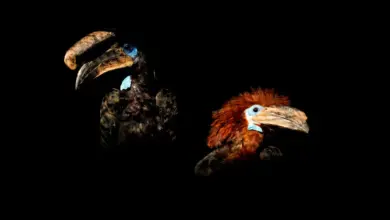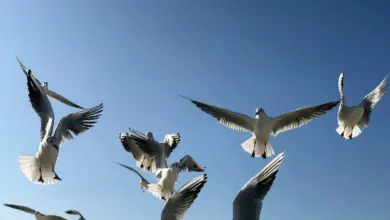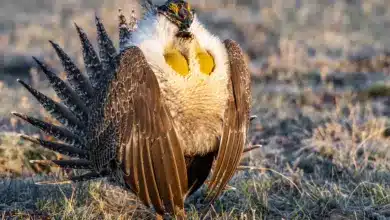The Australasian Shoveler (Anas rhynchotis) is dabbling duck found in heavily vegetated swamps in southwestern and southeastern Australia, Tasmania, and New Zealand.
This endangered species is protected in Australia under the National Parks and Wildlife Act, of 1974.
Know Everything About Australasian Shovelers
Introduction
The Australasian shoveler, or Spatula rhynchotis in scientific parlance, is a species of dabbling duck found in Tasmania, New Zealand, and Australia.
An impressive species of duck unique to Australasia, the Australasian Shoveler (Anas rhynchotis) is distinguished by its unusual shovel-shaped beak and fascinating habits.
This article explores the distinctive attributes, habits, and state of conservation of the Australasian Shoveler, highlighting its significance in the region’s fragile ecology.

Profile of Australasian Shovelers
It spans 46 to 53 kilometers. Swamps with dense vegetation are home to it. The National Parks and Wildlife Act of 1974 protects it in Australia.
Tasmania, New Zealand, and southwest and southeast Australia are the places where they may be found.
The man features a vertical white crescent in front of his eyes on a blue-grey skull. Nearly threatened is the Australasian shoveler’s status.
The male Australasian Shoveler has a black spoon-shaped beak and a blue-grey head. Its body has flecks of white and has a rich chestnut hue. The mottled-brown hue of females is duller.
An omnivore is the shoveler. It consumes seeds, crabs, and insects. While swimming, it holds its bill below the water’s surface and filters out food.
The male shoveler’s generally brown neck and wing feathers become blue-green during the mating season, which runs from August to December.
The brown feathers of the female remain the same throughout the year. The shoveler breeds year-round in arid regions following periods of intense rainfall.
In the dry regions of the continent, the Australasian Shoveler spawns almost year-round in readiness for the floods.
Nests are built in thick undergrowth on the ground, usually on a tree stump or submerged hole in water. The female is the only one who lays the eggs and raises the youngsters.
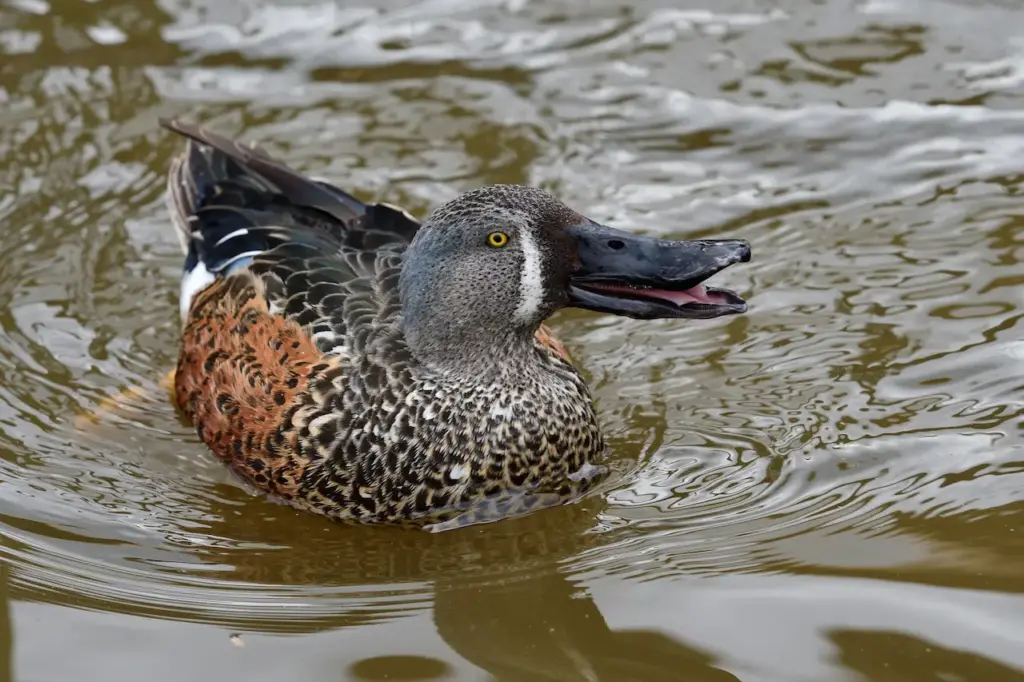
Description Of An Australasian Shoveler
The Australasian Shovers measures from 46–53 cm in length. The male can be identified by his blue-grey head with a vertical white crescent in front of the eyes.
Two Subspecies of Australasian Shovelers are recognized:
Australian Shovelers Anas rhynchotis rhynchotis – the nominate race – Found in southwestern and southeastern Australia and Tasmania.
New Zealand Shoveler,Anas rhynchotis variegata – Found in New Zealand.
The Australasian Shoveler is a dark-headed, low-floating duck with a hefty, square-cut beak that is shovel-tipped. Its brow slopes downward.
The male’s rich grey-blue head, with a white crescent vertically positioned between the brilliant yellow eye and the bill, is characteristic of breeding plumage. The shoulder and wing coverts are blue-grey with many white streaks, while the rump and back are black.
With white markings on the back of the flanks, the underparts are chestnut in color. The males are far duller when the mating season is over.
Females have dark brown eyes, chestnut underparts, and mottled brown upper-parts. Other names for this species include Blue-winged Shoveler, Spoonbill Duck, Shovelbill, and Stinker.
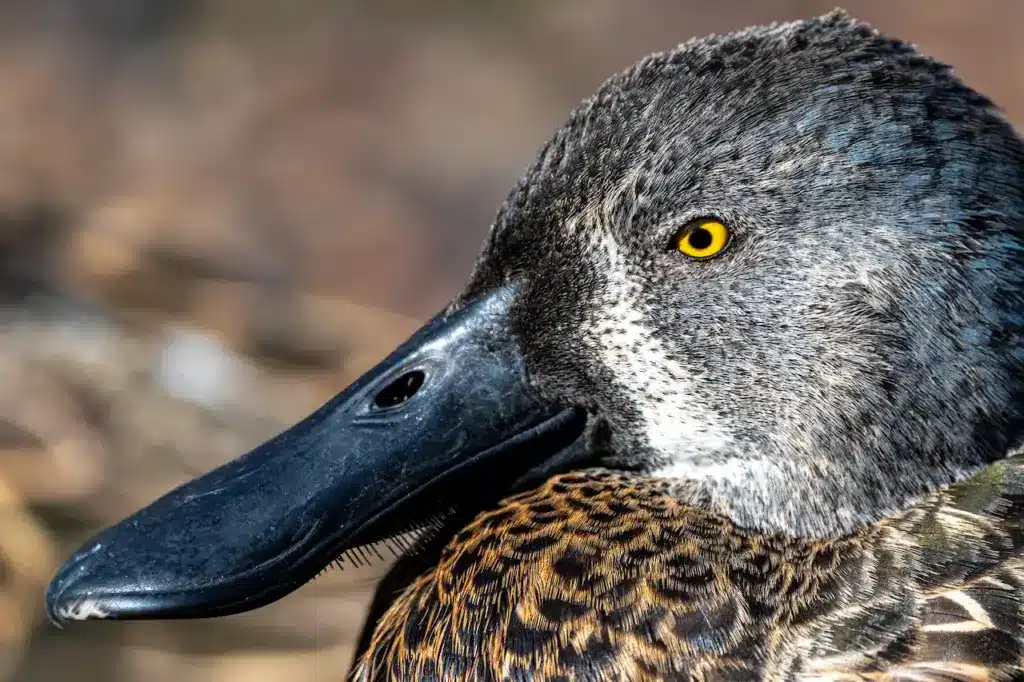
Habitat And Distribution
Ponds, rivers, estuaries, and other wetland environments are ideal for the Australasian Shoveler.
This species is incredibly versatile and can live in freshwater and saltwater habitats. Because it offers food and appropriate nesting grounds, areas with a lot of aquatic vegetation are especially home to these ducks.
With populations spread throughout Australia and New Zealand, the species has a broad geographic range throughout Australasia.
Although they are relatively widespread in specific locations, habitat degradation and environmental changes cause localised decreases.
Feeding Habits And Behavior
Due to the peculiar way they feed, Australasian Shovelers are recognised for their distinctive habits. Shovelers remove tiny creatures, insects, and seeds off the water’s surface by sweeping them from side to side.
They may flourish in various wetland environments because of their feeding approach, which also helps them fulfill their ecological role as seed disperses and consumers.
Males engage in elaborate wooing displays throughout the mating season to show off their colorful plumage and prove their fitness to prospective mates.
After forming a couple, the female builds a nest among thick, well-camouflaged foliage, and within she lays a clutch of eggs. The nesting behaviors of Shovelers are designed to shield their young from possible predators.
Reproduction of Australasian Shovelers
In New Zealand, courtship starts in August and involves the male drake making noises and bobbing his head as he swims toward the female duck.
Many drakes will frequently chase a pair of ducks that have already formed a bond. The married males are typically hostile and will not tolerate this behavior from the bachelors, which may lead to conflict.
Most courtship flights occur in the morning and evening, during which one or more (usually two) drakes quickly adopt the duck.
This puts the drakes’ speed and agility to the test. Even yet, the duck may be biased when choosing the winner of these tests, especially if she teamed with one of her numerous opponents.
If a male follows her and catches her uninterested, she will often spit him out in midair. With many more males than females, there is a clear and inexplicable difference in the sex ratio.
Movement Of Australasian Shovelers
Mostly sedentary within their range but also somewhat dispersive and nomadic, as some of their preferred areas may become unsuitable during droughts.
Most Australians occasionally congregate on dune lakes in southeast Australia, at the Murrumbidgee and Lachlan rivers’ meeting point, or on the Paroo and Cuttaburra Channels’ floodplains in northern New South Wales.
Birds from New Zealand have ventured to the Auckland Islands, and a recent study discovered that birds scatter widely after their yearly moult.
This was based on duck ringing recoveries from two S South I and two North I sites between 1972 and 1986; some of these birds were recovered less than 90 days after being trapped at opposite ends of the nation, but there was no discernible pattern.
Ducks from most of New Zealand’s extensive lowland and coastal wetlands were recovered; the modal recovery distances for birds ringed at L Whangape, North I, were 201–400 km, while for those ringed at sites on South I, they were 0–100 km in the same year and 101–200 km after that.
Ducklings ringed in Otago and Southland between 1971 and 1979 were the subject of a second New Zealand study, which found that 50% of recoveries were made in the same year, with two-thirds occurring within 200 km of the banding site.
However, later recoveries were more widespread, with recoveries on North I accounting for 28% of total recoveries, which could reach up to 1400 km from the banding site.
Additionally, species have, on occasion, ventured to New Caledonia.
Conservation Status
Although it is not considered a globally vulnerable species, environmentalists are concerned about regional reductions in the Australasian Shoveler. Their populations face severe risks from habitat loss brought on by urbanization, agricultural development, and changed water regimes.
Furthermore, changes in rainfall patterns and climate change may affect the availability of adequate breeding and feeding grounds.
The Australasian Shoveler’s long-term existence depends on conservation initiatives. Preserving their habitats requires initiatives like habitat restoration, protected wetland regions, and sustainable water management techniques.
Fostering a sense of responsibility for the preservation of these distinctive ducks is greatly aided by public knowledge and community engagement.
Final Thoughts
The Australasian Shoveler is an outstanding illustration of the rich and varied bird life seen in the Southern Hemisphere. Both scientists and bird enthusiasts are captivated by this duck species because of its unusual shovel-shaped beak, vivid plumage, and flexible lifestyle.
We must comprehend the distinctive traits and ecological functions of species such as the Australasian Shoveler as we work to preserve and safeguard the planet’s rich variety.
We can help ensure that these extraordinary ducks continue to thrive in the future by promoting conservation efforts, valuing wetland habitats, and cultivating tremendous respect for the natural world.


